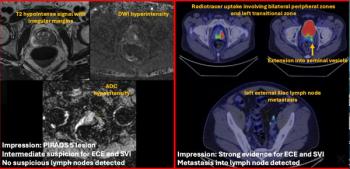
Radiology Assistants 101
Radiologist assistants are carving out their roles in radiology practice. Here's a look at their duties, licensing, and the impact they can have on a practice.
Radiologist assistants are a relatively new addition to radiology practices, as the profession has only existed for roughly 15 years. As RAs seek recognition from CMS for billing purposes, they are also continuing to carve out their role in radiology groups throughout the country.
Diagnostic Imaging spoke to Jason Barrett, a licensed radiologist assistant for six years and president of the Society of Radiology Physician Extenders, and Jerry Reid, executive director of the American Registry of Radiologic Technologists, to answer some of the basic questions about the profession.
What is a radiologist assistant?
Radiologist assistants is the generic term used to describe midlevel healthcare providers trained at a master's degree level to specifically to work in radiology under the supervision of a radiologist.
What education and training do RAs receive?
All RAs begin their careers as radiologic technologists. Twelve universities offer accredited education programs for RAs, and all of them require students to work as a technologist between one and five years before beginning a program. Most programs require three years working in the field, according to Barrett.
The programs are two years and include classroom work and onsite clinical work with a radiologist preceptor.
How are RAs licensed?
After graduating, RAs take one of two national certification examinations. Some take both, Reid said.
Both the American Registry of Radiologic Technologists (ARRT) and the Certification Board for Radiology Practitioner Assistants (CBRPA) have developed national certifications, Reid said. And both use slightly different designations, with ARRT referring to radiologist assistants as Registered Radiologist Assistants, or RRA, and CBRPA using Radiology Practitioner Assistants, or RPA.
To maintain either certification RAs must maintain certification and registration in radiography, complete approved continuing education every two years, and comply with strict professional standards of ethical conduct. Additionally, 29 states have developed licensing requirements recognizing RAs.
What kinds of procedures are RAs able to preform?
RAs can do everything a technologist can do, plus more. They have the ability to operate independent of in-the-room supervision from a radiologist and can perform a number of diagnostic studies and treatment procedures including many GI and chest examinations using contrast media administration, joint injections and lumbar punctures. A full list of the entry-level clinical requirements for ARRT certification can be seen
What kind of supervision is typically required for RAs?
RAs work for a radiologist and are under the supervision of the physician. They are typically employees of the radiology practice. However, they are allowed to provide patient care independent of having their supervising radiologist in the room. Typically, the radiologist is required to be on site.
On average, how much are RAs paid?
RAs earn between $75,000 and $140,000 annually, depending on experience, the region of country and how much responsibility they had, according to a salary survey conducted by CBRPA this year. Those RAs who are hired to strictly conduct diagnostic studies tend to earn less than those who take on more types of patient procedures, Barrett said.
Who employs RAs?
Radiology groups employ about half of RAs in the country, according to the CBRPA survey. Nearly 40 percent of RAs surveyed are employed by hospitals, with the remaining pointing to imaging centers as their employer.
Newsletter
Stay at the forefront of radiology with the Diagnostic Imaging newsletter, delivering the latest news, clinical insights, and imaging advancements for today’s radiologists.




























